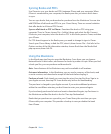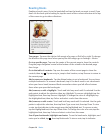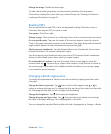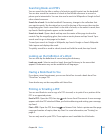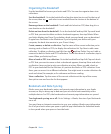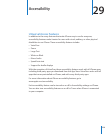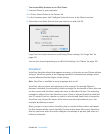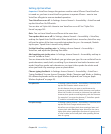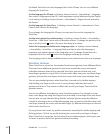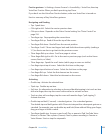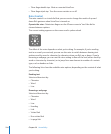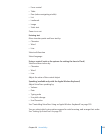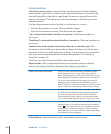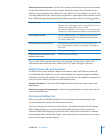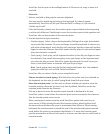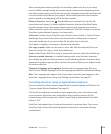
By default, VoiceOver uses the language that’s set for iPhone. You can set a dierent
language for VoiceOver.
Set the language for iPhone: In Settings, choose General > International > Language,
then select a language and tap OK. Some languages may be inuenced by the Region
Local setting. In Settings, choose General > International > Region Format and select
the format.
Set the language for VoiceOver: In Settings, choose General > International > Voice
Control, then choose the language.
If you change the language for iPhone, you may need to reset the language for
VoiceOver.
Set the rotor options for web browsing: In Settings, choose General > Accessibility >
VoiceOver > Web Rotor. Tap to select or deselect options. To change the position of an
item in the list, touch next to the item, then drag up or down.
Select the languages available in the Language rotor: In Settings, choose General
> Accessibility > VoiceOver > Language Rotor and tap to select the language or
languages you want to appear in the Language rotor. To change the position of a
language in the list, touch next to the language and drag up or down.
The Language rotor is always available when you’ve selected more than one language.
VoiceOver Gestures
When VoiceOver is turned on, the standard touchscreen gestures have dierent eects.
These and some additional gestures let you move around the screen and control
individual elements when they’re selected. VoiceOver gestures include two- and
three-ngers gestures to tap or ick. For best results when using two- and three-nger
gestures, relax and let your ngers touch the screen with some space between them.
You can use standard gestures when VoiceOver is turned on, by double-tapping
and holding your nger on the screen. A series of tones indicates that normal
gestures are in force. They remain in eect until you lift your nger. Then VoiceOver
gestures resume.
You can use dierent techniques to enter VoiceOver gestures. For example, you can
enter a two-nger tap using two ngers from one hand, or one nger from each hand.
You can also use your thumbs. Many nd the “split-tap” gesture especially eective:
instead of selecting an item and double-tapping, you can touch and hold an item with
one nger, then tap the screen with another nger. Try dierent techniques to discover
which works best for you.
If your gestures don’t work, try quicker movements, especially for double-tapping and
icking gestures. To ick, try quickly brushing the screen with your nger or ngers.
When VoiceOver is turned on, the VoiceOver Practice button appears, which gives you
a chance to practice VoiceOver gestures before proceeding.
232
Chapter 29 Accessibility



